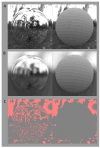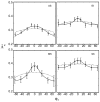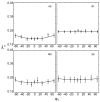Testing limits on matte surface color perception in three-dimensional scenes with complex light fields
- PMID: 18053846
- PMCID: PMC2190088
- DOI: 10.1016/j.visres.2007.09.020
Testing limits on matte surface color perception in three-dimensional scenes with complex light fields
Abstract
We investigated limits on the human visual system's ability to discount directional variation in complex lights field when estimating Lambertian surface color. Directional variation in the light field was represented in the frequency domain using spherical harmonics. The bidirectional reflectance distribution function of a Lambertian surface acts as a low-pass filter on directional variation in the light field. Consequently, the visual system needs to discount only the low-pass component of the incident light corresponding to the first nine terms of a spherical harmonics expansion [Basri, R., Jacobs, D. (2001). Lambertian reflectance and linear subspaces. In: International Conference on Computer Vision II, pp. 383-390; Ramamoorthi, R., Hanrahan, P., (2001). An efficient representation for irradiance environment maps. SIGGRAPH 01. New York: ACM Press, pp. 497-500] to accurately estimate surface color. We test experimentally whether the visual system discounts directional variation in the light field up to this physical limit. Our results are consistent with the claim that the visual system can compensate for all of the complexity in the light field that affects the appearance of Lambertian surfaces.
Figures










References
-
- Adelson E, Bergen J. The plenoptic function and elements of early vision. In: Landy MS, Movshon AJ, editors. Computational models of visual processing. Cambridge: MIT Press; 1991. pp. 3–20.
-
- Adelson EH. On seeing stuff: The perception of materials by humans and machines. In: Rogowitz BE, Pappas TN, editors. Proceedings of the SPIE Vol 4299. Human Vision and Electronic Imaging. VI. 2001. pp. 1–12.
-
- Arfken G. In Mathematical methods for physicists. 3. Orlando: Academic Press; 1985a. Spherical harmonics; pp. 680–685.
-
- Arfken G. mathematical methods for physicists. 3. Orlando: Academic Press; 1985b. Integrals of the products of three spherical harmonics; pp. 698–700.
-
- Basri R, Jacobs D. Lambertian reflectance and linear subspaces. International Conference on Computer Vision II; 2001. pp. 383–390.
Publication types
MeSH terms
Grants and funding
LinkOut - more resources
Full Text Sources
Miscellaneous

